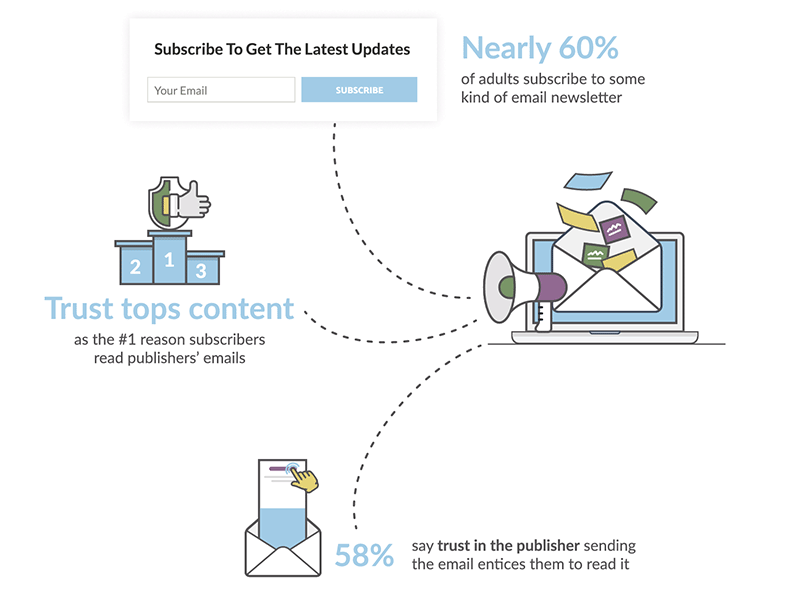Here is Why Big Brands Want to Sponsor Your Newsletter
Email newsletters have become a valuable tool for creators and influencers to build personal connections with their readers while also providing a platform for brands to sponsor and engage with potential customers.

Email newsletters are experiencing a surge in popularity, with creators and influencers building personal connections with their readers and attracting large brands as sponsors.
In fact, adding a newsletter to your blog or social media side hustle may be one of the best ways to earn income and provide your subscribers with something valuable too.
The Engagement Economy
Before sharing the three reasons brands want to sponsor your newsletter, let's provide a little context.
Paul Saffo is a technology forecaster and futurist who has written and spoken extensively on the impact of technology on society, business, and culture. He has been a consultant to many organizations, including the White House, and has taught at several universities, including Stanford and Singularity University. Saffo is also a fellow at the Institute for the Future, specializing in long-term forecasting and scenario planning.
Not too long ago, Saffo described the "engagement economy" as a shift from an attention-based economy to one focused on engagement.
In the attention economy, the goal is to capture people's attention in order to sell them something. Social media ads are a part of the attention economy, for example. Facebook will show you the same ad several times a day if its algorithms think you will likely make a purchase.
Unfortunately, all that "attention-grabbing" results in brands bombarding us with social media and search ads.
The engagement economy aims to build deeper, ongoing customer relationships by providing value, building trust, and fostering community.
Newsletters can help to do just this. When you write a newsletter, especially one connected with you personally, you are more like an influencer than a publisher. Your readers know you. They respect you. And when you have a sponsor in your newsletter, they think of it like a mini endorsement.
What's more, a newsletter is a picture of engagement. When someone opens your newsletter and reads it, they are giving it their full attention in that moment.
Newsletter Sponsorship
Newsletters work best when associated with a blog or a social media profile. So if you want to build a side hustle being a fishing influencer, consider starting a YouTube channel and a newsletter. If you want to be a cooking influencer, publish a blog and a newsletter.
The point is that having a home base or hub for your newsletter side hustle can be helpful.
Once you have your newsletter up and running, the thing you will be selling to sponsors is access to your audience. Remember, more than almost anything else, brands —especially established ones— need engagement.
When you accept a newsletter sponsor, you are endorsing that sponsor. So be selective. Your readers are likely to view the sponsorship ad as an endorsement.
This does not mean that your list with you and your mom on it will be worth something to brands. You will need to establish yourself. Aim to have about 2,500 or more subscribers before you start looking for sponsors.
The Reasons Big Brands Will Sponsor Your Newsletter
Time to get down to some of the specific reasons a brand will sponsor your newsletter within the context of the need for engagement.
No. 1: Trust
When someone subscribes to your email newsletters, they give you a measure of trust, and brands know this.
Think about the action of actively signing up for a newsletter. The subscriber actively enters an email address. Later, that same subscriber actively clicks a confirmation email. Very few platforms are so trusted.
"Among the nearly 60 percent of U.S. adults subscribing to some kind of email newsletter, trust in the publisher sending those newsletters is the number one reason subscribers open and read them. In fact, nearly two-thirds say trust is more important than the content itself in enticing them to read newsletters that hit their inbox. By contrast, only a third of Americans trust social media," according to a 2019 PowerInbox and Mantis Research survey.

What's more, 67 percent of subscribers will click a sponsor's ad because they trust the newsletter author.
No. 2: Context Relevance
Your newsletter represents a specific context that is similar to behavioral targeting.
When a marketing specialist at a brand or the brand's agency places an ad on Facebook or Instagram, for example, he or she will create an audience.
That audience will be based on some affinity or behavior. If the brand sells backpacks, our marketing specialist might target people who like backpacking. Obvious right?
So how does Facebook know who likes backpacking? The answer is behavior. If someone "liked" a post about backpacking or listed backpacking as a hobby, Facebook knows the brand's ads will be relevant.
The same thing happens when someone subscribes to a backpacking newsletter. That subscriber is demonstrating his or her interest in backpacking. Thus, brands know that a given newsletter is contextually relevant.
No. 3: Connection
For the past decade or more, many brands have relied on invasive, privacy-trashing tracking methods to target consumers.
A movement toward more personal privacy has signaled the end of practices like third-party cookies and given rise to active ad-blocking and legislation like the California Consumer Privacy Act, the European Union's General Data Protection Regulation (GDPR), and a slew of similar regulations.
Brands know that they need to find new ways to market, given that their current channels could change significantly. Well, newsletters might be just the opportunity they need.
A newsletter is delivered directly to an individual via a media that is more popular with working demographics than social media or television.
Your newsletter is just the thing they need to reach potential customers.
Summing Up
Email newsletters have become a valuable tool for creators and influencers to build personal connections with their readers while also providing a platform for brands to sponsor and engage with potential customers.
The engagement economy has shifted the focus from an attention-based economy to one based on building trust, fostering community, and providing value. Your newsletter can help brands achieve this.